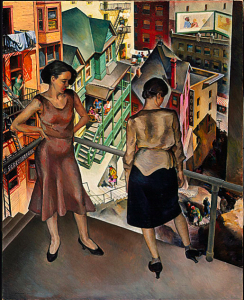Recently I couriered Millard Sheets’ Angel’s Flight (1931) across town to the Autry National Center, where it is included in the groundbreaking new exhibition Siqueiros in Los Angeles: Censorship Defied, the first examination of the seven pivotal months the great Mexican muralist David Alfaro Siqueiros spent in Los Angeles in 1932. I was on hand to make sure LACMA’s painting was safely unpacked, installed and prominently featured. Angel’s Flight is one of our most important paintings, so we rarely lend it. But this loan request was especially compelling: visitors would be able to see Sheets’ masterpiece in the context of Siqueiros’ landmark contemporaneous work in Los Angeles, where both painters knew each other and achieved artistic and professional breakthroughs in the space of a few short months.

Angel's Flight, Millard Sheets, 1931. Copyright: Millard Sheets Estate.
In 1931, Sheets, just 24 years old, completed Angel’s Flight, a dramatically composed and inventive view of downtown L.A. that refers to, but does not picture, the electric cable railway that used to carry pedestrians in downtown Los Angeles to the top of Bunker Hill between 1901 and 1969. Entered by invitation (his first) into the 30th Annual International Exhibition of Paintings held at the Carnegie Institute in Pittsburgh, Sheets submitted Angel’s Flight, which was praised by critics nationwide, including at the New York Times, which reproduced the work. In early 1932, the painting was back in Los Angeles for the Thirteenth Annual Painters and Sculptors Exhibition at LACMA’s forerunner, the Los Angeles Museum of History, Science, and Art, where it won the $100 painting prize. All of this caught the attention of Mrs. L. M. Maitland of Beverly Hills, who bought the painting for the museum. The Los Angeles Times reported in May: “Famed Work of Art Wins Home Here,” and Mrs. Maitland stated “I gave the museum the picture first of all because I like it, and secondly because I believe Los Angeles art patrons should buy the work of our own artists here.” It is entirely possible that once Siqueiros was in L.A. by June of 1932 he saw and was impressed by Sheets’ unique and masterful vision of the downtown L.A. urban scene pictured in Angel’s Flight and now part of the museum’s permanent collection. Then he actually met Sheets while a guest professor at Chouinard Art School, where Siqueiros taught a course on fresco painting, a class that Sheets went on to teach that fall. Siqueiros’ soon formed his “Bloc of Painters,” a group of American artists then active in L.A. that included Sheets, Reuben Kadish, Harold Lehman, Fletcher Martin, Phil Paradise, Barse Miller, Paul Sample, Philip Guston, and many others. The Bloc of Painters helped Siqueiros complete three murals in L.A.: one for a private residence in Pacific Palisades, Street Meeting, right on Chouinard’s wall, Tropical America on Olvera Street. But the public murals proved highly controversial: the little known histories of the intertwined careers of the Bloc of Painters and the art of Siqueiros as well as the legacy of Siqueiros’ near deportation and his 1932 Los Angeles murals are uncovered in this fascinating and must-see exhibition. Austen Bailly



